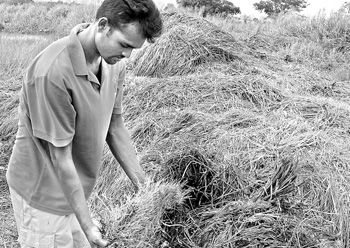
Down come the rains to break paddy bowlsThe present government has given high priority to increasing domestic food production in Sri Lanka, and foremost in this list of priorities is its firm commitment to increasing rice production. Farmers were offered many incentives and facilities to boostrice production -- fertilizer at subsidized prices, agricultural credit, seed paddy of high yielding varieties, a guaranteed price per kilo of paddy, a network of purchasing centres etc. Farmer response was admirable. Area under rice cultivation increased. Overall management of rice fields improved. A bumper harvest was expected. Never before had farmer expectations been so high and upbeat. Then, the unexpected and unthinkable happened. As the main harvesting season approached (February -- March 2008), incessant rains lashed the country's rice fields. To fully comprehend the nature and magnitude of damage to a mature rice crop by heavy rainfall and the impact of such a disaster on the lives of the farming community, one needs to be a perceptive observer, or better still, experience the reality by oneself.
Thirty years ago, the author and his family experienced a similar situation when they were operating a small rice farm in the Mahiyangana area (bordering Mahaweli System C). Their experience was described as follows: "For days on end a watery curtain descended on the land. The first gusts of wind and rain flattened our paddy to the ground. More rain and the fields were flooded. We struggled valiantly to drain the fields of the treacherous water. We hoped and prayed for a lull in the weather. Still there was no respite -- the rain continued to fall. Some of the grains began to germinate on the panicles ('ear') itself. Panic gripped us. There was no alternative now but reap the sodden crop as soon as possible. With the help of all available labour we worked feverishly at reaping the paddy. The freshly reaped paddy was then placed on the bunds ('levees') for the water to drain off. Then, during the brief spells of dry weather, the paddy was carried to the earthen threshing floor ('Kamata"). Threshing was however impossible since the earthen threshing floor was also sodden. The paddy was now stacked around the periphery of the 'Kamata" hoping it would dry out sufficiently to permit threshing by the use of a tractor. The next day, more grains were seen to germinate. Desperation set in. There was no alternative now but to heap the wet paddy on the sodden 'Kamata' and carefully run a tractor over it to ensure separation of the grain from straw (threshing machines were not available at the time). This turned out to be a hopeless task. Within a few hours the fruits of the 'green revolution' were a steaming mass of fermenting grain unfit even to be consumed by swine!” Experiences like the above are never forgotten. They leave an indelible impression on one's memory. It was therefore natural that we should like to investigate and see for ourselves how today's rice farmers were coping with the caprices of nature. History repeats itself Lacking state patronage or NGO support, we decided to hitch a ride in a friend's four-wheel drive vehicle. As such our investigation was confined to just one day visiting Mahaweli System-C (Girandurukotte, Dehiattakandiya) and adjacent areas (Mapakada, Dambarawa and Sorabora). Sure enough, it was a case of history repeating itself. Flattened rice fields, grains germinating on the panicles, earthen threshing floors oozing water, heaps of wet paddy stacked around every bit of available high ground and occasionally we could see a threshing machine at work. Farmers call this machine ‘Tsunami', and its operation is referred to as ‘Tsunami gahanawa’. This machine is said to be capable of threshing even wet paddy.
They are owned and operated by a few 'Mudalalis' who do custom threshing charging rupees 2,000 to 2,500 an hour. Apparently, this machine is capable of threshing one hectare of paddy (yielding approximately 5 tonnes of grain) in a mere three hours of operation. To do so, the paddy has to be reaped, tied into bundles, and transported to a central spot. It also requires 6 to 8 units of labour to continuously feed the machine. Only a few farmers are fortunate enough to have access to these machines -- both machines and ready cash (amounting to approximately rupees ten thousand) to pay the 'Mudalai' and hired labour being in short supply. The freshly threshed grain still needs to be dried. Farmers do not have access to grain driers. Sun drying is not possible during rainy weather. What then? Spread the grain inside their houses and resort to continous spreading out. How does one spread out five tonnes of paddy in a little farm house? There just isn't enough space. So, much of the wet paddy has to be heaped up and left out in the open (covered with plastic sheeting). Inside the mound of heaped grain, the temperature rises rapidly. Some grains begin to germinate; others ferment. "Kata kiyantada deviyane?" Service Providers - Where are they? The government maintains an enormous bureaucracy at public expense to service the rice farmer. This consists of the Department of agriculture (DOA) responsible for research, extension and seed supply and the Department of Agrarian Services (DAS) also responsible for input supply and extension through a multitude of field staff called Agricultural Production and Research Assistants (APRA). There is also an agency providing crop insurance, a number of banks (both state and private) entrusted with the responsibility of disbursing credit. Within 'Mahaweli areas' (such as Girandurukotte and Dehiattakandiya), extension (mainly transfer of technology) has been entrusted to the Mahaweli Authority of Sri Lanka (MASL) which maintains an even higher density of officers and field staff. Recent years have also seen a dramatic increase in the private sector's involvement in service provision -- supply of seed, fertilizer, agro-chemicals, farm machinery and marketing. Adding to this scenario are the NGOs both local and foreign. This makes us wonder whether the number of service providers and their personnel outnumber our farmers!! Does no one care? During our brief visit to the areas mentioned, we did not see any of the service providers mentioned above interacting with the distraught farmers. Mudalalis owning the 'tsunami' thresher were the only service providers in evidence. Even the rice mill owners had stopped purchasing their paddy at the time (due to poor quality) according to our informants. "How about the many officers (Niladhari)," we asked them. "None at all mahathmaya," they replied. Except for an occasional politician and a few media personnel, no one appeared to be interested in their plight. Role of service providers Are disbursement of credit, supply of seed, fertilizer and agro-chemicals; conducting farmer training classes pertaining to new improved rice varieties, application of compost and organic matter, pest and disease management and weed control all that is expected of our farmer support services? Are service providers not expected to monitor the performance and measure the impact of the services provided by visiting and consulting farmers out in the fields? Let us explore this subject a little further. Thanks to our rice breeders and some research workers ably assisted by a handful of dedicated extension personnel in the department of agriculture, we have seen a dramatic increase in rice yields in recent years. However, of what use is increased rice production if farmers are unable to effectively handle the increased output? This year's ruined rice harvest bears eloquent testimony to the fact that our post harvest technology is hopelessly inadequate. The proponents of new technology must ensure that they think through the entire process of technology transfer. Let's not blame it all on the freak weather. Even during the best of times (when there is no rain during harvest), the majority of our rice farmers in major rice growing areas resort to threshing on earthen threshing floors by getting a tractor to run over the reaped paddy. This results in lowered quality of rice (due to broken grains plus dust and sand). What of the private sector-- that much publicized "engine of growth"? Do they not need to be out in the field at times like this assessing the impact of their services? This was a golden opportunity for manufacturers and dealers in rice processing machinery to be out in the field demonstrating/testing their equipment. This could result in increased sales, and perhaps in improved equipment. Even the Shylocks in the banking sector appeared to be hibernating inside their air conditioned cocoons! Do they not need to find out why so many small farmers default on their cultivation loans? Perhaps they may have been more interested if they realized that they would have more business promoting grain processing equipment among local entrepreneurs. Limits of new technology The 'new improved rice varieties' (high yielding) promoted by the department of agriculture, are often inferior to many indigenous rice varieties in that they lack seed dormancy. Indigenous varieties do not germinate for several months, even when exposed to wet conditions. Indigenous/traditional rice varieties yield much less. Ironically, many small farmers are better equipped to handle such low yields by merely spreading the grain inside their houses (should the paddy be wet). We realized this ourselves when we were operating our little farm (in 1978). Our rice crop out yielded that of fellow farmers by a factor of four, but we lost most of it during very wet weather. Seeing our plight, one peasant farmer made the following comment: "This is like suffering from indigestion by trying to eat too much"! Bureaucratic indifference and arrogance. Having realized (by hind sight) that we could have coped with unexpected heavy rains during the harvest, and perhaps saved much of our rice harvest if we had access to effective mechanical threshers and grain drying equipment, we addressed a letter to a government agency specifically entrusted with the responsibility of designing and testing farm machinery. We asked them for advice on the availability of such equipment. Thirty years ago such machinery was relatively unheard of in our country. Having failed to receive a reply to our query for more than a month, we sent them a reminder, drawing attention to our first letter. Their response was curt and shocking. "We do not need grain driers because we live in the tropics where there is plenty of sunshine. You are requested to address your query pertaining to threshing machines to private dealers of farm machinery." The author holds a Masters' degree in agriculture from the Philippines University and a Diploma in agriculture (First class) from the School of Agriculture, Peradeniya. He has been a researcher at the International Rice Research Institute in the Philippines and Dept. of Agriculture, Peradeniya. He has also personally operated a two hectare farm in Mahiyangana for ten years (1969-78), and served as a freelance consultant in agriculture and rural development to a number of local and International NGOs. |
|
||||||
|| Front
Page | News | Editorial | Columns | Sports | Plus | Financial
Times | International | Mirror | TV
Times | Funday
Times || |
| |
Reproduction of articles permitted when used without any alterations to contents and a link to the source page.
|
© Copyright
2008 | Wijeya
Newspapers Ltd.Colombo. Sri Lanka. All Rights Reserved. |

